→ Contents
| Flash Compendium |
|---|
Flash Timing Diagrams
The following timing diagrams were taken with an oscilloscope with an optical receiver attached. They are probably of interest for the techies and provide a deeper insight into the Minolta flash system.
I've used a Dynax 7, representing film cameras, and a 7D, representing digital cameras.
Dynax 7
Regular flash
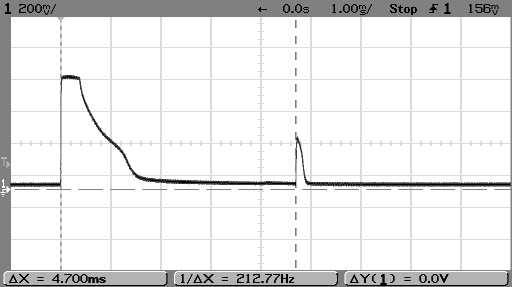
| TTL-OTF with Dynax 7 and built-in flash |
|---|---|
| This is a regular flash exposure with the built-in flash. The first peak is the flash going off and being cut off after some time. The second smaller peak is a mystery to me. It appears about 1/200 s after the main flash, well within the 1/40 s exposure time. | |
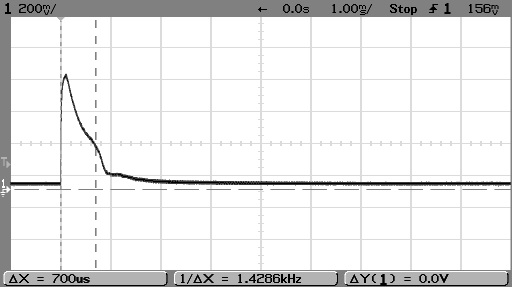
| TTL-OTF with Dynax 7 and external flash |
| This is the same exposure with an external flash. The main pulse is shorter, but probably stronger (the amplitude in these diagrams is not to scale). The second smaller pulse is missing. | |

| HSS with Dynax 7 and external flash |
| This is High Speed Sync in action. First, there's a metering flash. It's followed about 1/12 s later by the main flash which is much wider than regular. |
Wireless flash

| Wireless TTL with Dynax 7 (test flash only) |
|---|---|
| These are the control pulses from the built-in flash when you press the AEL button to test the wireless connection. There are three short pulses, with the first two close together. The main flash responds about 1/2 s later (not in diagram). | |

| Wireless TTL with Dynax 7 (with main flash) at 1/60 s |
| This is a complete wireless flash exposure at a slow exposure time. First, there are two control pulses from the built-in flash, and about 20 ms later there is the main flash and the stop pulses (intermixed). | |

| Wireless TTL with Dynax 7 (with main flash) at 1/80 s |
| Here is the same exposure, but with a shorter exposure time. With exposure times shorter than 1/60 s, the Dynax 7 (and later cameras) use a new protocol. There are two start pulses, a longer pulse (maybe for pre-flash metering), four more control pulses, and the main flash. Earlier (non-D) flashes do not understand this new protocol, and are not triggered when exposure times are shorter than 1/60 s. | |
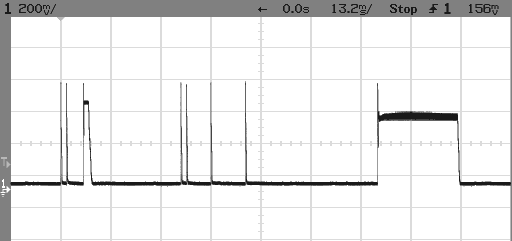
| Wireless HSS with Dynax 7 (with main flash) |
| If you decrease the exposure time below the x-sync speed, the 7 uses Wireless HSS. The protocol is similar to that of exposure times between 1/60 s and x-sync speed, but there's the typical flat pulse of HSS as the main flash. |
Dynax 7D
Regular flash

| Pre-flash TTL with Dynax 7D and built-in flash |
|---|---|
| The 7D always uses some kind of pre-flash metering with automated flash. With the built-in flash, there are 4 metering pulses, and at about 1/7 s later, there's the main flash. I have no idea why there are 4 metering pulses. One should be enough. The long delay between metering flash and main flash is the reason why you often find people with their eyes closed on photos taken with flash. They start to blink when they see the metering flash, and the photo is taken just when their eyes are closed. | |

| Pre-flash TTL with Dynax 7D and built-in flash (metering flashes only) |
| These are the 4 metering pulses above. | |

| Pre-flash TTL with Dynax 7D and external flash |
| With an external flash, there's only a single, longer metering flash. Again, the main flash follows about 1/7 s later. | |

| Pre-flash TTL with Dynax 7D and external flash (metering flash only) |
| This is the metering flash zoomed into. | |

| HSS and pre-flash TTL with Dynax 7D and external flash |
| HSS with the 7D is almost identical to HSS with the 7. The only difference is that the delay between metering flash and main flash is slightly longer. |
Wireless flash
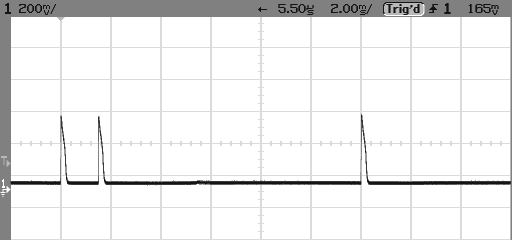
| Wireless flash with Dynax 7D (test flash only) |
|---|---|
| The wireless test function of the 7D is identical to that of the 7. | |
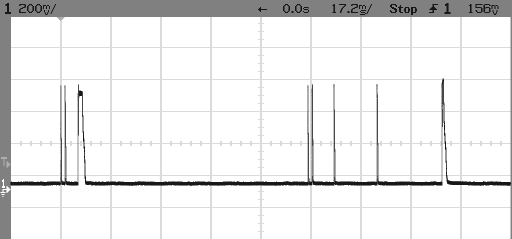
| Wireless flash with Dynax 7D (with main flash) at 1/40 s |
| As you can see, the 7D always uses the new wireless protocol, even for exposure times longer than 1/60 s. This is required because the new protocol includes a metering flash, which the 7D needs, as it can not perform OTF metering. This is also the reason why the 7D does not trigger non-D flashes in wireless mode. These flash units simply do not understand the new protocol. | |

| Wireless flash with Dynax 7D (control pulses only) at 1/40 s |
| These are the control pulses and the metering flash at the beginning of the sequence. | |

| Wireless HSS with Dynax 7D (with main flash) at 1/200 s |
| Wireless HSS is again almost identical to that of the 7. It's used for exposure times shorter than the x-sync speed. |
Ralph Wagner has asked me to host his own set of measurements. He has put together two PDF files containing his own results. Here they are:
© 2008 Michael Hohner; This page was last changed on 2008-04-24
